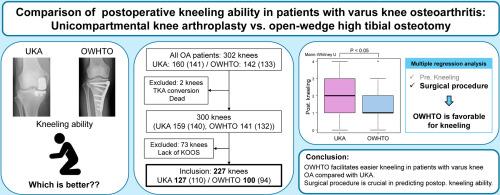Comparison of post-operative kneeling ability in patients with varus knee osteoarthritis: unicompartmental knee arthroplasty versus open-wedge high tibial osteotomy
引用次数: 0
Abstract
Purpose
This study compared post-operative kneeling abilities following unicompartmental knee arthroplasty (UKA) and open-wedge high tibial osteotomy (OWHTO) for varus knee osteoarthritis.
Methods
This retrospective cohort study included 127 knees that underwent UKA and 100 knees that underwent OWHTO between 2018 and 2022. Clinical data, including Knee injury and Osteoarthritis Outcome Score (KOOS) and the University of California, Los Angeles (UCLA) activity score, were collected pre-operatively and at a minimum 12 month follow-up. Kneeling ability was defined using the KOOS Sp5 subscore. Factors influencing post-operative kneeling, including age, pre- and post-operative knee flexion angle, pre-operative UCLA activity score, degree of osteoarthritis, femorotibial angle, pre-operative kneeling ability, and surgical procedure, were evaluated using multiple linear regression analysis.
Results
OWHTO demonstrated significantly better post-operative kneeling ability than UKA. Pre-operative kneeling ability and surgical procedure statistically significantly influenced post-operative outcomes (regression coefficient −0.50, 95% confidence interval −0.003–0.99; p = 0.049).
Conclusions
OWHTO was significantly associated with better Sp5 scores and improved post-operative kneeling ability, emphasizing the importance of choosing the appropriate surgical technique for better post-operative kneeling ability.

内翻膝骨性关节炎患者术后跪下能力的比较:单室膝关节置换术与开楔胫骨高位截骨术
目的:本研究比较单室膝关节置换术(UKA)和开楔胫骨高位截骨术(OWHTO)治疗膝内翻性骨关节炎后的跪下能力。方法本回顾性队列研究包括2018 - 2022年间127例UKA和100例OWHTO膝关节。临床数据,包括膝关节损伤和骨关节炎结局评分(oos)和加州大学洛杉矶分校(UCLA)活动评分,在术前和至少12个月的随访中收集。跪拜能力用oos Sp5评分来定义。采用多元线性回归分析评估影响术后跪下的因素,包括年龄、术前和术后膝关节屈曲角度、术前UCLA活动评分、骨关节炎程度、股骨胫骨角度、术前跪下能力和手术方式。结果sowhto术后跪下能力明显优于UKA。术前跪地能力和手术方式对术后预后有统计学显著影响(回归系数- 0.50,95%可信区间- 0.003-0.99;p = 0.049)。结论sowhto可提高Sp5评分,改善术后跪下能力,强调选择合适的手术技术对提高术后跪下能力的重要性。
本文章由计算机程序翻译,如有差异,请以英文原文为准。
求助全文
约1分钟内获得全文
求助全文

 求助内容:
求助内容: 应助结果提醒方式:
应助结果提醒方式:


